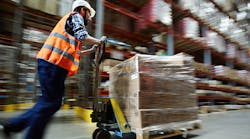New technologies in warehouses are showing up for many reasons. A new study from UC Berkeley Labor Center found that on the one hand tight labor markets, rising real estate costs, and increasing speed requirements are pushing warehouse operators to explore new technologies.
On the other hand, variability and unpredictability, outsourcing dynamics, inertia, and the state of technological innovation are factors that may slow the process of technology uptake.
Due to this, the group projects that despite widespread reports about job loss in this sector, they don’t see this happening.
What they do see is that over the next decade the content and quality of these jobs will shift as technologies are adopted for particular tasks.
Some of the changes could be negative, however. Employers could use technology to decrease the skill requirements of jobs in order to reduce training times and turnover costs and this could lead to wage stagnation and job insecurity.
Another adverse application of technology could be electronically mediated forms of monitoring and micro-management that threaten to constrain workers’ autonomy and introduce new rigidities into the workplace.
Here are some findings from the study on the impact of technology on tasks, jobs and workers.
1. New technologies are likely to lead to work intensification.
The highest priority for companies in the short term is to identify and implement technologies that support more efficient order fulfillment. This includes applying labor-saving technologies to high-volume e-commerce order picking and frequent, small-batch replenishments to retail stores that keep limited inventory on hand. The labor-intensive nature of picking individual items to assemble orders—so-called “each picking”—requires large numbers of workers, so warehouse operators place great value on finding ways to reduce headcount and/or increase throughput by reorganizing this activity.
Our research suggests that even though some technologies could alleviate the most arduous tasks of warehouse work (such as heavy lifting), this likely will be coupled with attempts to increase the workload and pace of work, with new methods of monitoring workers. Amazon, for example, introduced MissionRacer, a video game that pits workers against one another to assemble customer orders fastest.
The increasing pace of work in warehouses may introduce new health and safety hazards, as well as increased employee turnover due to overwork and burnout. Currently, warehouse workers experience work-related injuries at a rate nearly twice that of other private industry workers— higher than construction, coal mining, and most manufacturing industries. According to The New York Times, pregnant workers at a warehouse in Memphis managed by the 3PL XPO were denied requests for light-duty and subsequently suffered miscarriages. Warehouse employees also often toil in facilities that are not climate controlled, which exacerbates the hazards created by work speed-up.
2. New technologies have the potential to de-skill some jobs.
Some warehouse technologies are designed to simplify aspects of warehouse work by breaking a job into subtasks and, where possible, removing the skills required of the workforce. Across all occupations in warehouses, viable technologies are likely to replace some human-performed decision-making tasks with machines, significantly changing the composition and quality of jobs. In some cases, the de-skilling appears to be motivated by a desire to shift labor strategy, including expanding the size of the potential labor market, increasing the use of temporary workers, reducing the workforce in certain occupations, and enhancing worker productivity.
Training workers to perform higher-skilled tasks is one potential avenue for adaptation to technological change, but this strategy appears to be underutilized in warehousing. Instead, labor reallocation likely will dominate in the short and medium-term, supported by processes of de-skilling and work intensification. For example, the Kiva robotic picking system simplifies the role of humans in picking, reducing training and skill requirements, and making it easier for companies to hire temporary labor rather than direct employees.
3. New technologies are poised to transform how workers are managed.
Algorithmic management introduces new forms of workplace control, where the technological regulation of workers’ performance is granular, scalable, and relentless. Newly available devices—such as “wearable” warehouse technologies, autonomous mobile robots, and increasingly sophisticated labor management software—allow close tracking of workers’ movements, including walk speed, routes, bottlenecks, and break time.
These technologies have the potential to improve efficiency by urging workers to increase speed and accuracy. These same technologies also can function as a form of surveillance over workers, reducing the little autonomy they already have and further intensifying the pace of their work. Without interventions to ensure the transparency and fairness of the algorithms used in these technologies, the conditions of work in warehouses may be heading toward more rigid forms of monitoring and management.
For further findings see the full report.



